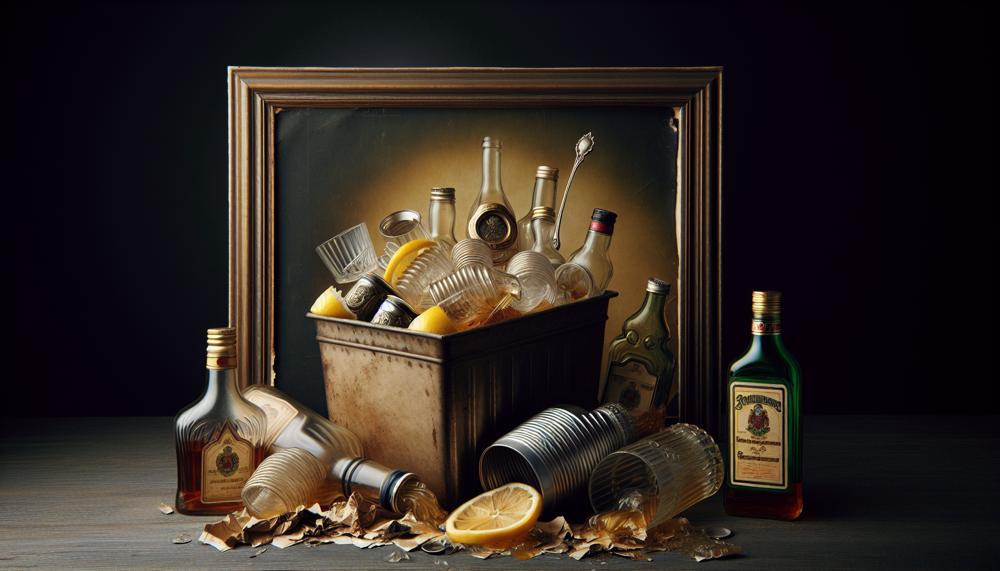Do you have a collection of dusty, forgotten liquor bottles hiding in the back of your cabinet? Or perhaps you inherited some vintage bottles that have been gathering dust for decades. It’s time to bid farewell to those old spirits and make room for something new.
But before you start dumping them down the drain or chucking them in the trash, there are a few things you should know. Improperly disposing of alcohol can harm the environment and pose safety risks.
So let’s raise a glass (of water) and toast to responsibly getting rid of our old booze.
In this blog post, we’ll cover all the ins and outs of safely disposing of old liquor. From understanding the environmental impact to determining if your liquor is still safe to consume, we’ve got you covered. Plus, we’ll explore different methods for disposing of unopened and opened bottles, as well as proper techniques for different types of alcohol.
We’ll also share alternative options for getting rid of old liquor besides throwing it away.
So, grab a drink and join us as we dive into the world of responsible liquor disposal.
Contents
How to Properly Dispose of Bad Wine
When it comes to getting rid of spoiled wine, there are several safe and effective methods you can use. These include pouring it down the sink, using it in cooking, or seeking professional assistance. Let’s break down each method and discuss how to properly execute them:
- Pouring down the sink: This is the simplest way to dispose of bad wine. Just pour it down the kitchen sink while running warm water to dilute any acidic elements. Keep in mind that this method is only suitable for small amounts of wine (up to two bottles per day) and should be done with caution.
- Using in cooking: If the wine is still within its shelf life and appears to be safe, you can incorporate it into recipes that require alcohol. However, keep in mind that cooking does not completely eliminate the alcohol content.
- Seeking professional help: If you have a large quantity of spoiled wine or are unsure about how to dispose of it, it’s best to contact your local hazardous waste facility or waste management services for guidance. They have the expertise and resources to handle hazardous materials safely and legally.
Additional tips and considerations:
- Never pour old liquor down the drain without diluting it first. This can cause damage to your plumbing system.
- Always check expiration dates and quality before using old liquor for cooking.
- Consider making vinegar out of unfinished wine instead of throwing it away.
- Reuse empty wine bottles for home décor or as decanters after sterilizing them.
- In July 2024, California will add wine and liquor bottles to its recycling program.
| Method | Instructions |
| Pouring down the sink | To dispose of bad wine, pour it down the kitchen sink while running warm water to dilute any acidic elements. Only pour a maximum of two bottles per day and be cautious. |
| Using in cooking | If the wine is still within its shelf life and safe to consume, use it in recipes that call for alcohol. However, keep in mind that cooking does not completely remove the alcohol content. |
| Seeking professional help | If you have a large quantity of spoiled wine or are unsure about how to dispose of it, contact your local hazardous waste facility or waste management services for guidance. |
In addition to these methods, there are some important things to keep in mind when disposing of bad wine:
- Never pour old wine down the drain without diluting it first. This can cause damage to your plumbing system.
- Always check expiration dates and quality before using old wine for cooking.
- Consider making vinegar out of unfinished wine instead of throwing it away.
- Reuse empty wine bottles for home décor or as decanters after sterilizing them.
How to Make Red Wine Vinegar Out of Old Wine
Yes, homemade red wine vinegar can be easily crafted from old wine. Here is a simple step-by-step guide to safely make it:
- Collect the necessary materials: You will require a large glass or ceramic container, a funnel, a cheesecloth or coffee filter, and a bottle with a tight-fitting lid.
- Mix the ingredients: Combine three parts of old red wine with one part of red wine vinegar in the container. Opt for high-quality red wine for the best results.
- Cover and allow it to age: Cover the container with a cheesecloth or coffee filter secured with a rubber band. Place it in a dark and cool spot and let it sit for three to four weeks. The optimum temperature for the vinegar to ferment is between 60-80°F.
- Monitor the progress: After about two weeks, check on the vinegar. You should witness a thin, scummy layer forming on the surface – this indicates that fermentation is taking place.
- Strain and bottle: Once the vinegar has reached your desired level of acidity, strain it through a cheesecloth or coffee filter into a clean bottle with a tight-fitting lid.
- Age it for another month (optional): For a more intricate flavor, you can allow the vinegar to age for an additional month before using it.
- Indulge in your homemade red wine vinegar: Store your homemade red wine vinegar in a cool and dark space and use it for cooking or dressing salads.
Using Old Wine for Cooking
Not only will you be able to use up your old wine, but you’ll also be able to create a unique and flavorful ingredient for your cooking.
In addition to this, there are several other ways to incorporate old wine into your cooking, such as using it in marinades, sauces, and braising liquids for added depth of flavor.
If you’re interested in making your own vinegar, simply combine one part old wine with three parts water and let it sit in a sterilized glass jar or bottle for 2-4 weeks. Stir occasionally and strain out the solids before storing the vinegar in a sealed container for up to 6 months. For a delicious salad dressing, mix together old wine vinegar, olive oil, minced shallot, and herbs and seasonings of your choice. This vinaigrette can be used immediately or stored in the fridge for up to a week.
For a classic French dessert, try poaching pears in red wine. Simply simmer peeled pears in a mixture of red wine, sugar, and spices until tender. And if you’re looking for a tasty marinade for meat, adding old wine as a base can help tenderize the meat and add flavor. For savory dishes like sauces and gravies, old wine can be used as part of the liquid to enhance the overall taste. And don’t worry about having too much leftover wine – you can freeze it in ice cube trays for later use.
Another great way to use old wine is in braising meats. This slow-cooking method allows the wine to add complexity and richness to the dish. Just remember to use a dry red or white wine that complements the type of meat you are cooking.
And after cooking, don’t forget to make a delicious pan sauce by deglazing the pan with some old wine.
How to Remove Labels from Wine Bottles
Through extensive research, we have discovered the most efficient way to remove labels from wine bottles without causing any damage or leaving behind residue. Wet removal methods, such as soaking the bottle in Oxiclean solution or hot water, have proven to be the most effective.
Other options, such as dry removal methods like the label lift method, or using heat through methods like steaming or heating in an oven, are also viable alternatives. It is crucial to exercise caution and patience when removing labels to avoid tearing or creasing them.
Certain materials may require specific techniques, like using heat for plastic labels and wet methods for paper labels.
With careful handling and the right approach, you can successfully remove wine labels without causing any damage or leaving behind any residue.

Removing Labels from Wine Bottles:
| Method | Description | Pros | Cons |
|---|---|---|---|
| Wet Removal Method (soaking in Oxiclean solution or hot water) | Soaking the bottle in a solution of Oxiclean or hot water to loosen the adhesive of the label and make it easier to remove. | Effectively removes labels without damaging the bottle or leaving residue. Easy to do with common household items. | May take longer than other methods. Some labels may still be difficult to remove. |
| Dry Removal Method (label lift method) | Using a tool, such as a plastic card, to carefully lift and peel off the label from the bottle. | Quick and easy method. Less messy than wet methods. | May leave behind residue if not done carefully. May not work on all label types. |
| Heat Methods (steaming or heating in an oven) | Applying heat to the label to loosen the adhesive and make it easier to remove. | Effective for labels that are difficult to remove. Can be done quickly and easily. | Requires caution to avoid damaging the label or bottle. May not work on all label types. |
Aside from selecting the appropriate method for removing labels, it is important to consider the disposal of wine bottles. Liquor, including wine, can pose a danger if not disposed of correctly.
Before disposing of old liquor, check its expiration date and quality. While pouring it down the sink or using it for cooking may be common methods of disposal, they may not be suitable for all types of liquor.
If unsure, seek professional assistance from your local hazardous waste facility or waste management services.
How to Poach Fruit in Old Wine
A unique and delicious way to utilize old wine is by poaching fruit in it. This process involves cooking ripe and firm fruits in a mixture of sugar, water, spices, and old wine at a low temperature. The result is soft, infused fruit with complex flavors and a tender texture. This method also balances out any tartness with added sweetness and creates a flavorful syrup that can be used in various ways.
To start, carefully check the expiration dates and quality of the old wine to ensure it is still safe to use. Once confirmed, combine the wine with sugar, water, and spices in a pot over low heat. As the mixture simmers, the flavors will infuse into the fruit, creating a deliciously unique taste. The low temperature also breaks down the fibers in the fruit for a tender texture.
Once the fruit is fully cooked and infused with the flavors of the liquid, it can be served on its own or used as a topping for desserts or yogurt. The remaining poaching liquid can also be reduced to create a flavorful syrup that can be used in cocktails or as a glaze for meats.
When disposing of old wine, it’s important to choose appropriate methods such as pouring it down the sink or using it for cooking. If you are unsure about its quality or expiration date, seek professional help to ensure safe disposal.
Using Old Wine for Cooking
Using old wine for cooking adds a unique and rich flavor to dishes, making it a valuable ingredient in the kitchen. However, it is important to properly handle and store old wine to ensure its safety and prevent waste. Here are some useful tips for using and disposing of old wine:
- Properly store old wine: To maintain the quality of old wine, keep it away from heat sources and store it in a cool, dark place. This prevents oxidation and allows the wine to remain safe for up to two months after opening.
- Check the shelf life of different types of wine: The shelf life of old wine varies depending on its type, with red wines having a longer lifespan compared to whites, and fortified wines lasting even longer. It is crucial to check the expiration date of your bottle before using it for cooking.
- Freeze leftover wine: If you have excess wine that you do not plan on using immediately, consider freezing it in ice cube trays. This prevents spoilage and allows for easy use of small portions in cooking.
- Repurpose old wine: Even if old wine has turned vinegary, it can still be put to good use. Consider making homemade vinegar or jelly with it, or use it as a fly trap.
- Get creative with recipes: There are endless possibilities for incorporating leftover wine into dishes. From savory red wine reduction sauces to flavorful wine-infused dishes, there are countless ways to elevate your meals with old wine.
How to Remove Labels from Wine Bottles
When it comes to removing labels from wine bottles, there are several methods that can be used without causing damage to the bottle or label. These techniques include wet removal, physical removal, dry removal, and heat methods.
It is important to choose the appropriate method based on the type of label and to handle the process with care in order to preserve the quality of the label.
Vinegar can also be utilized to remove any residue left on the bottle after removing the label. In the event that the label cannot be removed intact, taking a photo of it is a viable alternative for preserving it.
| Method | Description |
|---|---|
| Wet Removal | Soaking the bottle in warm water or using a damp cloth to dissolve the traditional adhesive used in labels. |
| Physical Removal | Using tools such as heat or razor blades to peel off stickers or labels that are not attached with traditional adhesive. |
| Dry Removal | Using baking soda, ammonia solution, or label lifts to remove labels without using water. |
| Heat Methods | Applying heat sources such as oven heating or steaming to loosen the adhesive of the label and remove it intact. |
| Vinegar | Utilizing vinegar to remove any residue left on the bottle after removing the label. |
| Photographing | Taking a photo of the label as an alternative way of preserving it if it cannot be removed intact. |
When removing labels from wine bottles, it is crucial to select the appropriate method based on the type of label. Wet methods are most effective for traditional adhesive-based labels, while physical methods such as heat or razor blades are more suitable for stickers.
Dry removal methods can also be effective, particularly for labels with a paper backing. Heat methods are best for labels that need to be removed intact, and a combination of chilling and steaming can be used as a last resort if other methods fail.
No matter which method is chosen, it is essential to handle the process with caution in order to avoid damaging the bottle or label. This may involve experimenting with different techniques or utilizing gentler methods such as soaking the bottle in warm water instead of scrubbing with abrasive materials.
Furthermore, using vinegar to remove any residue left on the bottle after removing the label can help preserve the quality of the bottle.
How to Poach Fruit in Old Wine
To create a mouth-watering and exceptional dessert, follow these essential steps for poaching fruit in old wine:
Step 1: Choose the Perfect Wine
Opt for a bottle of sweet dessert wine that is too sugary to drink. It will be ideal for poaching fruit.
Step 2: Select the Right Fruits
Pick out underripe fruits, as they will soften and become sweeter when poached.
Step 3: Prepare the Fruits
Peel and remove any cores from the fruits, depending on the type of fruit being used.
Step 4: Poach the Fruits
- In a pot, combine the old wine with water, sugar, and any desired spices or herbs. Bring to a boil and then reduce to a simmer.
- Carefully place the fruits into the poaching liquid and let them simmer until they are tender and infused with flavor.
Step 5: Serve and Delight
- Remove the fruits from the poaching liquid and let them cool slightly before serving.
- The poached fruits can be savored on their own or used in other delectable desserts, such as tarts or cakes.
Also Read: Can You Recycle Ice Cream Cartons?
Conclusion
In conclusion, disposing of old liquor should not be taken lightly. Simply dumping it down the drain or throwing it in the trash can have harmful consequences for the environment and safety risks. Therefore, it is crucial to consider the environmental impact and determine if the liquor is still safe to consume before deciding on a disposal method.
We have explored various options for getting rid of both unopened and opened bottles of liquor, as well as alternative uses such as making vinegar or incorporating it into cooking. Additionally, we have shared tips on properly disposing of bad wine, including never pouring it down the drain without diluting it and checking expiration dates before using it for culinary purposes.
Moreover, we have provided a step-by-step guide on how to create homemade red wine vinegar from old wine. This not only repurposes your old spirits but also produces a unique and flavorful ingredient for your dishes.
Lastly, we have discussed methods for safely removing labels from wine bottles without causing damage or leaving behind residue. From wet methods like soaking in Oxiclean or hot water to dry techniques like label lifting and heat methods such as steaming or heating in an oven – caution and patience are key to successfully removing labels.





